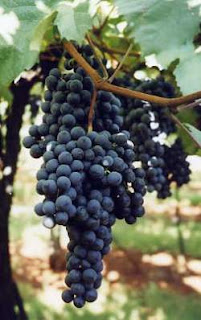Besides Brachetto d'Acqui and possibly Symphony, I don't know that I've really written very much about sweet or dessert wines. Even though I happen to be a fan of sweet wines, I don't drink or buy them that often. I think it's mostly because I've got this equation set up in my head where sweet wines = dessert wines, and the simple fact of the matter is that when I'm at home, I don't eat a lot of dessert. Cost is another factor as good sweet wines are usually made in a way that requires an awful lot of grapes to produce a little bit of wine, such as wines made from raisined, frozen or botrytis-infected grapes, which tends to result in higher prices. The spectrum of prices for sweet wines is much more compressed since they tend to start out higher on the low end than table wines, even if they flatten out faster at the high end. High end Bordeaux, Burgundy and California table wines can run you $5,000 right out of the gate while the greatest Sauternes wine (and, arguably, the greatest sweet wine on earth), Chateau d'Yquem, will probably run between $300 and $400 for a half bottle. Regardless of price, though, sweet wines definitely have their place at the table and I often find myself wondering why I don't drink more of them.
All of this is in introduction to today's grape, Aleatico. Aleatico is a red Italian grape whose origins are very unclear. There are written records dating back to the 14th Century which refer to the "Livatica" grape, which is commonly believed to be Aleatico (Livatica is also known as Liatico or Agliano so you put the two together and you get Aleatico). It was thought for awhile that Aleatico was simply a red-skinned mutation of Muscat Blanc a Petits Grains, but recently DNA research seems to point to Muscat as a parent to Aleatico rather than a mutation (the other parent was unable to be identified). The deep, intense color of Aleatico wines are also a big strike against the mutation theory, as the red-skinned clones of the Muscat family do not possess anything resembling the deep color of Aleatico. Nobody disputes that the grape has some link to the Muscat family of grapes, though, and once you try the wine, it's pretty easy to see why.
Another point of confusion with Aleatico is the matter of exactly where it's from. There are a lot of grapes growing in Italy today that at one point in time came over from Greece, but it isn't clear whether Aleatico is one of those grapes or not. There are some who maintain that it is a Greek import and others who claim that it's native to southern Italy (specifically Apulia). Whatever the case turns out to be, Italy is the grape's current home. There are a few DOCs and one DOCG scattered across Italy that showcase Aleatico. Most of it is grown in either Apulia, Lazio or Tuscany, though there are limited plantings in a few other Italian regions. Interestingly, Aleatico is one of the few grapes grown on the Tuscan island of Elba and wines made from the grape were purportedly one of Napolean's few sources of solace during his exile there. It is grown in limited quantities in other parts of the world like Chile, where it is known as Red Moscatel, and, surprisingly, in places like Uzbekistan and Kazakhstan.
Aleatico plantings seem to be on the decline throughout Italy, but I was fortunate enough to come across the 2006 bottling from Nanerone called "Piandibugnano" Aleatico di Toscana IGT at Bin Ends for $29 (500mL). In the glass, the wine was an inky, dense, almost black color with a very narrow purple rim. The wine had a grapey, flowery aroma very similar to other muscat-based wines. On the palate, the wine was thick, but not syrupy, with nice acidity that was on the higher side of medium and, strangely, just a bit of fine, dusty tannin. The wine was definitely sweet with ripe purple grape flavors along with some lychee and boysenberry jam fruit. I had originally thought this might be lightly fortified, but have since learned (from my friends at The Wine Bottega) that this is in fact made in the passito method, where grapes are fully or partially dried before pressing. I was a little surprised, as this clocks in at 15% alcohol, but it carries it very well. The flavors here aren't particularly complex, but they're very intense and focused. My sum-up note reads: "kind of like port spiked with Welch's or flat grape soda," which is not a knock on the wine in any way as I found it very enjoyable. This is a home run with chocolate but has enough berry fruit flavors to complement a dark fruit cobbler or something in that vein. This is a very reasonably priced dessert wine that you should definitely try if you run across it.


No comments:
Post a Comment